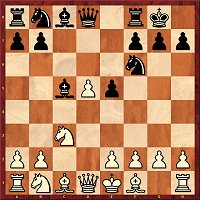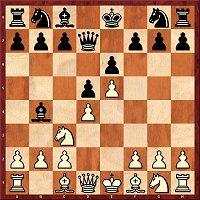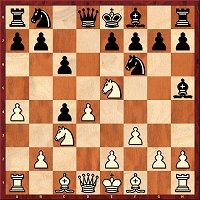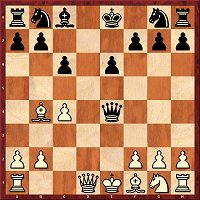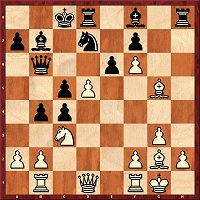|

| Intro
What all is there on the new DVD? Grandmaster Karsten Müllergives you a survey in his introductory videoand at the same time shows you which moves and strategies he has best liked this time in the games of the top grandmasters, for instance Kramnik’s victory over McShane and Karjakin’s trick in his rook ending against Morozevich. From the 11 openings articles on the DVD Müller has chosen to present, e.g., Kuzmin’s repertoire suggestion against the Caro-Kann (Advance Variation with 4.h4 and 5.g4). |
| 
| Tournament Highlights Romanian grandmaster Dorian Rogozenco starts his video introduction to the tournaments of November and December with the game Topalov-Nisipeanu from the Kings Tournament in Bucharest. Of all the players who took part in the Grand Prix event in Tashkent it was above all Alexander Morozevich who impressed Rogozenco and we get an insight into two of his games (against Kamsky and Leko). Magnus Carlsen’s great performance in London is illustrated with his games against McShane and Polgar. |

| Pure training In this issue we again have all the games with training questions brought together. A click on the icon on the left opens the relevant list with 47 games this time. |
| 01.12.-10.12.2012 
Magnus Carlsen
Who else?
| London Chess Classic 2012 The course of this fourth staging of the super-tournament in London remained exciting right till the end. Magnus Carlsen did set a fantastic pace, but Vladimir Kramnik also was never very far behind the favourite and before the final round he had at least a theoretical chance of winning the tournament. But Kramnik had a quick draw against Adams and Magnus Carlsen was still playing for a win against Vishy Anand even when his victory in the tournament was already assured. With five wins, three draws and an Elo performance rating of 2994, Carlsen thus won for the third time the London Chess Classic. Second place went to Kramnik, who also won back his second place in the world ranking list. |

Kramnik,V - McShane,L
Position before 17.a5
| On the DVD Vladimir Kramnik annotates his victory over Luke McShane. Against the latter’s Slav with 4...a6 the ex world champion introduced in the form of 11.Bf4 an "interesting, though anything but clear" innovation. What is quite clear, however, is the sharp character this gave to the game. McShane accepted doubled pawns on f7/f6, but obtained in return a nice outpost for his knight on b3. But just after 16...Nb3 Kramnik set his opponent the first really difficult decision with the exchange sacrifice 17.a5. What would be Black’s best reaction to it? McShane thought for almost an hour and yet he did not find the best continuation. Click on the link under the diagram and play through the game with the revealing analyses Kramnik. |

"Mickey" annotates
Adams,M - Polgar,J
| Michael Adams also has the right to consider himself another winner in the tournament. He may not have made it quite to the top, but he had started out with two losses and had there not been the defeat at the hands of Carlsen... On the DVD he annotates his win against Judit Polgar from the third round. In doing so, he explains, for example, his anti-Sicilian plan (3.g3, 4.Bg2, 5.Qe2 followed by an exchange on d5 and 0-0). If you play through the game with his analyses, the way he sets out his game and achieves the win actually appear quite simple. |
 | On the DVD you will find 19 games (which constitutes more than half of the games from London) with audio commentary by the players. Together with the presenters Daniel King, Nigel Short, Steven Gordon, Lawrence Trent, etc. the stars explain the decisive moments in their games. You will find the analysis by the stars in the tournament report on the London Chess Classic. |
| 22.11.-04.12.2012 
Victorious trio with the president
| FIDE GP Tashkent 2012 During the second tournament of the new FIDE cycle, almost every one of the participants was at one point in the sole lead. It was an extremely close-fought tournament and fittingly things were not decided until the final round. In it the Chinese player Wang Hao scored an important victory in the top duel with Mamedyarov, since, had he won, the latter could have become sole victor of the tournament. This meant that Wang Hao, like Karjakin and Morozevich, finished with 6.5 points from 11 games, And even the next three places were shared: 6 out of 11 meant that Kasimdzhanov, Mamedyarov and Caruana occupied fourth to sixth places. |

FIDE GP Tashkent 2012
Openings report
| Almost all the games from Tashkent have been annotated in detail on the DVD. In addition, Romanian grandmaster Mihail Marin has brought together for you in his openings report the latest trends and ideas. As well as Marin, GMs Ftacnik, Krasenkow, Kritz, Mekhitarian, Postny and Sumets have contributed analyses. |

Karjakin annotates
Karjakin,S - Morozevich,A
| In one of the deciding games Sergey Karjakin had a hard-fought victory over his future co-winner Morozevich. Karjakin analyses this game himself on the DVD and in doing so starts by conceding that his opening surprise completely backfired. It was not till the rook ending that Russian, who had the white pieces, slowly managed to set up some pressure thanks to the weak black queenside pawns. The end – Morozevich’s mistake on move 52 – you probably know already from Karsten Müller’s video introduction. |
| 07.11.-13.11.2012 
Vassily Ivanchuk
wins in a tiebreak
| Kings Tournament Bucharest 2012 The “Tournament of the Kings” was staged in 2012 for the first time in the capital of Romania. In Caruana, Topalov, Ivanchuk and Nisipeanu the organisers had assembled a small but promising field of participants. Numerous missed chances throughout the tournament led not only to a high number of draws but also to tension right to the very end. Apart from Nisipeanu, the only player who actually had to admit defeat, all three of the others still retained a chance of winning the tournament on the eve of the final round. But two rather uneventful draws in the last round left Ivanchuk and Topalov to contest a blitz tiebreak, which the Ukrainian had the good fortune to win. |
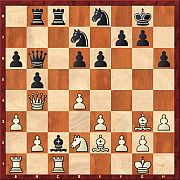
Ivanchuk,V - Nisipeanu,L
Position before 20.a4
| The DVD offers extensive analysis ofr all the games from Bucharest, above all by one of the tournament organisers ChessBase author Dorian Rogozenco. At this point, we should like to present to you in brief the only two decisive games from Bucharest – both annotated by Michal Krasenkow; all the other games can be found via the link above. In Ivanchuk-Nisipeanu the Romanian tried in a Nimzo-Indian with 4.Qc2 to get some play with the pawn sacrifice 6...b5. But the future tournament winner did not allow himself to be led astray, retained the initiative and quickly homed in on the black pawn weaknesses. In the position in the diagram Ivanchuk played 20.a4 and after the inaccurate 20...bxa4 21.Qxb6 Nxb6 22.Bxa6 Rc7 23.Bb5 obtained a clear advantage and soon afterwards also won the a-pawn. |

Topalov,V - Nisipeanu,L
Position after 16.exf4
| In the game Topalov-Nisipeanu who offered a pawn in the opening. And it was the pawn sacrifice which has become popular in recent years 7.d5 in the Queen’s Indian. Topalov innovated with 12.Bf4. The ex world champion then allowed the bishop to be exchanged, but in return he obtained powerful pressure down the d-file (diagram) and a clear and lasting initiative. Topalov later forced the decision with the help of an exchange sacrifice to which Nisipeanu did not find the correct reply. However, Krasenkow points out in his analysis that the Bulgarian would instead have been better liquidating to a rook ending. Because from an objective point of view the sacrifice was probably not the best choice. |
| 
Anna Ushenina
14th Women’s World Champion
| World Women’s Champion Anna Ushenina annotates We have a new women’s world champion. The women’s WCh 2012 was held in KO format in Khanty-Mansiysk – for the favourites it was a bit of a trial, but it gave its chance to outsiders such as Anna Ushenina! On the way to the chess throne she eliminated two clearly more favoured competitors in Anna Muzychuk and Nadezhda Kosintseva. And in an up-and-down final against Stefanova the new and 14th women’s world champion won through in the tiebreak with a score of 1.5:0.5. This year already, Ushenina will have to defend her title in a match against the winner of the Grand Prix series, Hou Yifan. |
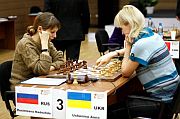
Ushenina,A - Kosintseva,N
The women’s world champion annotates
| The 27 year old women’s grandmaster from the Ukraine has selected two of her best WCh games to annotate for this issue of ChessBase Magazine. On the way to the semi-final Ushenina sacrificed her a-pawn for a lasting initiative and for a powerful centre. In her analysis she picks out the decisive moments of the game and shows how both sides could have played even better. Click on the link under the photo and play through the game with the comments of the new women’s world champion! |
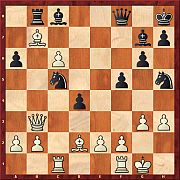
Ushenina,A - Stefanova,A
Position after 22...Nd7-c5
| The third game of the final saw a sharp line of the Chebanenko Variation of the Slav defence to the Queen’s Gambit. In time-honoured fashion, Ushenina gave up two pieces for an exchange and won several pawns at the same time. In addition, a passed pawn on c7 guaranteed her lasting positional superiority. In the position on the board Ushenina found the tactical knock-out blow. The game continued 23.Qb6 Nxb7. can you see how the Ukrainian now won a decisive amount of material? Stefanova went on to defend valiantly, but she was on a loser. |
| 
Viktor Bologan
Expert knowledge in the Chebanenko Slav
| Viktor Bologan explains the Chebanenko Slav After a long pause Viktor Bologan has once more taken up the Chebanenko Slav in his repertoire – with fresh ideas and carefully prepared analyses. His starting point comes after the moves 1.d4 d5 2.c4 c6 3.Nc3 Nf6 4.e3 a6 5.Nf3 and now 5...Bf5 – a totally bold bishop move which has been the subject of criticism above all because of 6.Qb3. In over 20 minutes the grandmaster from Moldava explains to us how Black can achieve promising positions with the equally risky 6...b5 and what subtleties have to be borne in mind. Of course, alternatives for White on move 6 are also explained. Whoever plays this variation with either White or Black will certainly be able to draw enormous benefit from this video. |
| 
This original position after only three moves is the starting point. You should be able to guess the next move for Black (after 4.h3). See Move by Move
| From the opening trap to the endgame study Training in ChessBase Magazine starts with the very first moves and includes all the phases of a game of chess. The 11 up-to-date openings articles with many ideas and suggestions for your repertoire can be found above among the links. Rainer Knaak’s Opening Trap (including a Fritztrainer video) involves this time a trap in the Max Lange Attack (1.e4 e5 2.Nf3 Nc6 3.Bc4 Nf6 4.d4 exd4 5.0-0 Bc5 - C56). Also produced in video format are the openings contributions by Alexei Shirov (Najdorf Variation), Leonid Kritz (Sicilian Rossolimo Variation) and Viktor Bologan (Chebanenko Slav). You will find these videos in the column Opening Videos. In Daniel King’s long-running Move by Move there is a game with the move order 1.e4 d6 2.g3 Nf6 3.Bg2 h5. Peter Wells’ subject in his Strategy column is called: "Bishops of opposite colours – just the same old story" (Part 2)? And in the columns on Tactics (subject: diabolical diagonal shifts) and Endgames (subject: fortresses and the art of defence) Oliver Reeh and Karsten Müller have once more brought together for you all that is best in current tournament practice. |





















